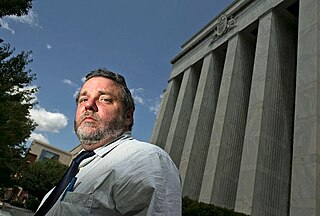A spree killer is someone who commits a criminal act that involves two or more murders in a short time, often in multiple locations. There are different opinions about what durations of time a killing spree may take place in. The United States Bureau of Justice Statistics has spoken of "almost no time break between murders", but some academics consider that a killing spree may last weeks or months, e.g. the case of Andrew Cunanan, who murdered five people over three months.
A modus operandi is someone's habits of working, particularly in the context of business or criminal investigations, but also more generally. It is a Latin phrase, approximately translated as 'mode of operating'.
The National Center for the Analysis of Violent Crime (NCAVC) is a specialist FBI department. The NCAVC's role is to coordinate investigative and operational support functions, criminological research, and training in order to provide assistance to federal, state, local, and foreign law enforcement agencies investigating unusual or repetitive violent crimes.

Robert K. Ressler was an FBI agent and author. He played a significant role in the psychological profiling of violent offenders in the 1970s and is often credited with coining the term "serial killer", though the term is a direct translation of the German term "Serienmörder" coined in 1930 by Berlin investigator Ernst Gennat. After retiring from the FBI, he authored a number of books on serial murders, and often gave lectures on criminology.

In criminology, a disorganized offender is a type of serial killer classified by unorganized and spontaneous acts of violence. The distinction between "organized" and "disorganized" offenders was drawn by the American criminologist Roy Hazelwood. These profiles were also studied and modified in the FBI's Behavioral Science Unit located in Quantico, Virginia. By classifying these offenders into different categories, the FBI is able to track down offenders by studying their behavior and habits.

Offender profiling, also known as criminal profiling, is an investigative strategy used by law enforcement agencies to identify likely suspects and has been used by investigators to link cases that may have been committed by the same perpetrator. Multiple crimes may be linked to a specific offender and the profile may be used to predict the identified offender's future actions.

John Edward Douglas is an American retired special agent and unit chief in the United States Federal Bureau of Investigation (FBI). He was one of the first criminal profilers and has written and co-written books on criminal psychology, true crime novels, and his biography.

The Hi-Fi murders were the torture of five people resulting in three deaths during a robbery at the Hi-fi Shop, a home audio store in Ogden, Utah, on the evening of April 22, 1974. Several men entered the Hi-fi Shop shortly before closing time and began taking hostages. They were forced to drink corrosive drain cleaner, which the perpetrators believed would fatally poison their hostages, but instead caused burns to their mouths and throats. Further violence included kicking a pen into an ear and the brutal rape of an eighteen-year-old girl, before three of the victims were fatally shot. The two surviving victims were left with life-changing injuries.

Martha Ann Johnson is an American suspected serial killer from Georgia convicted of smothering to death one of her children in 1982, and suspected of smothering to death three of her other children between 1977 and 1982.
The FBI method of profiling is a system created by the Federal Bureau of Investigation (FBI) used to detect and classify the major personality and behavioral characteristics of an individual based upon analysis of the crime or crimes the person committed. One of the first American profilers was FBI agent John E. Douglas, who was also instrumental in developing the behavioral science method of law enforcement.
Property crime is a category of crime, usually involving private property, that includes, among other crimes, burglary, larceny, theft, motor vehicle theft, arson, shoplifting, and vandalism. Property crime is a crime to obtain money, property, or some other benefit. This may involve force, or the threat of force, in cases like robbery or extortion. Since these crimes are committed in order to enrich the perpetrator they are considered property crimes. Crimes against property are divided into two groups: destroyed property and stolen property. When property is destroyed, it could be called arson or vandalism. Examples of the act of stealing property is robbery or embezzlement.
On January 27, 2001, Dartmouth College professors Half and Susanne Zantop, aged 62 and 55 respectively, were stabbed to death at their home in Etna, New Hampshire. Originally from Germany, the couple had been teaching at Dartmouth since the 1970s. High school classmates James J. Parker, age 16, and Robert W. Tulloch, age 17, were charged with first-degree murder.
Michael Mark Welner is an American forensic psychiatrist and Chairman of The Forensic Panel. Welner is best known for his work in sensitive and complex litigation. He has acted as lead forensic psychiatric examiner in numerous criminal or court proceedings of national and international prominence, including precedent-setting trials and higher court decisions. Welner is also known for a number of innovations in forensic science, forensic psychiatry and justice, including protocols for prospective peer review in forensic medicine consultation, research to standardize an evidence-based distinction of the worst crimes, The Depravity Standard, and recommendations for upgrading forensic science assessment. He has been featured in network television news coverage of forensic psychiatry issues, has authored publications for professional and public audiences, and has contributed to emerging legislation on mental health reform.
Kirsten Marina Costas was an American high school student who was murdered by her classmate Bernadette Protti in June 1984.

The Behavioral Science Unit (BSU) is the original name of a unit within the Federal Bureau of Investigation's (FBI) Training Division at Quantico, Virginia, formed in response to the rise of sexual assault and homicide in the 1970s. The unit was usurped by the Critical Incident Response Group (CIRG) and renamed the Behavioral Research and Instruction Unit (BRIU) and currently is called the Behavioral Analysis Unit (5) (BAU-5) within the National Center for Analysis of Violent Crime (NCAVC). The BAU-5 currently works on developing research and then using the evidence-based results to provide training and improve consultation in the behavioral sciences—understanding who criminals are, how they think, why they do what they do—for the FBI and law enforcement communities.
The Macdonald triad is a set of three factors, the presence of any two of which are considered to be predictive of, or associated with, violent tendencies, particularly with relation to serial offenses. The triad was first proposed by psychiatrist J. M. Macdonald in "The Threat to Kill", a 1963 article in the American Journal of Psychiatry. Small-scale studies conducted by psychiatrists Daniel Hellman and Nathan Blackman, and then FBI agents John E. Douglas and Robert K. Ressler along with Ann Burgess, claimed substantial evidence for the association of these childhood patterns with later predatory behavior. Although it remains an influential and widely taught hypothesis, subsequent research has generally not validated this line of thinking.

Peter Joseph "Pete" Shellem was an investigative reporter for The Patriot-News. He was instrumental in obtaining the release of five wrongfully convicted innocent people:
A signature crime is a crime which exhibits characteristics idiosyncratic to specific criminals, known as signature aspects, signature behaviours or signature characteristics. Where a modus operandi (MO) concerns the practical components of a crime which can also be unique to one suspect, signature aspects fulfill a psychological need and, unlike the MO, do not often change.

Ann C. Wolbert Burgess is a researcher whose work has focused on developing ways to assess and treat trauma in rape victims. She is a professor at the William F. Connell School of Nursing at Boston College.

Ronald Shelton, better known as The West Side Rapist, was an American convicted serial rapist. He was convicted of raping over 30 women in Cleveland, Ohio, over a 6-year period. He may have raped up to 50 women. Shelton was caught on video using an ATM with his victims' bank cards.










